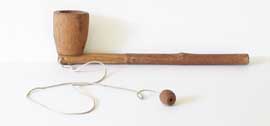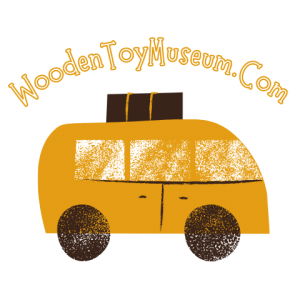The object of this game is to swing the ball into the cup. It’s harder than it looks!
Wooden Toy Museum: Games Collection: Ball and Cup Game

Why Do Children Need Toys?
Children are never too young to become interested in math and science. In fact, young children are natural scientists and mathematicians. They are curious. They ask questions all the time. They like to explore and experiment. When you encourage their questions and help them explore and find out the answers, you are building their interest in math and science. And children who have such experiences when they are very young develop an enjoyment and confidence in math and science that pay off when they’re older.
As many parents have discovered, the toys we buy for our kids are not always what they enjoy playing with. How many parents have bought their toddler a cool toy only to have that cast aside while the toddler bangs on a pot with a wooden spoon?
Kids are full of boundless curiosity and what they need is something (toy or not) that will help them explore their senses or the world around them. What we think are simple things are amazing discoveries to a child. A tiny baby is fascinated by his fingers and what they do. A toddler is interested in the sound that things make when they hit the floor. A small child bouncing a ball can play for hours.
Anyway, I guess we don’t really *need* toys. My kids can have just as much fun playing outside and running around and drawing or coloring etc. Children have always had toys throughout history, granted they were not always as flashy as they are today. Toys comfort them and help development.
Ask the kids what’s tops on their Christmas lists and you’ll likely hear gaming systems, DVDs, cell phones, and iPods. Ask some adults what should top the kids’ Christmas lists and you’re likely to hear books, toys that teach, toys that foster imaginative play, and sporting equipment — reinforcing the idea that children learn best through play.
“For older kids, a lot of electronic stuff is true, but you need to think about how to balance that out. If you do the electronic things, you balance it by giving them some things that are going to be activating and other things that will stimulate creative thinking,” said Rebecca Isbell, director of the Centre for Early Childhood Learning and Development at East Tennessee State University.
Playing is important to children. It is the way they practice growing up. Toys are the tools children use in play. Toys can be purchased, or they may be as simple as kitchen pan lids or paper sack puppets. Anything children can play with safely can be a toy. In fact, you may have watched infants open presents and noticed that they spent more time playing with the ribbon and wrapping than with the toy inside.
Try to remember two or three of your favorite toys. Were they the ones you created yourself or ones someone made for you? All children are natural learners; constantly absorbing new experiences in their everyday lives. Therefore the toys they play with play an integral part in this learning process.
All children develop at different rates, while some may be walking at 10 months others are still toddling and falling at 15 months. Some children have strong abilities in one field while others are adept at another field. Therefore developmental guidelines should be used as a general rule of thumb.
Some of the most educational toys out there are simple alphabet blocks and magnetic letters. You and your child can make words with them, sort them into groups, or just review what sound each letter makes as you place it on a tower or shape. You can count them and add or subtract from the piles. Starting this process very early can lead to big rewards when your child is ready to start reading and it can be a great deal of fun, too. Colouring books, simple mazes, and empty notebooks to fill with their own creations can encourage your child to exercise the small muscles in their hands so that, when it comes time to start writing, they can control the pencils and crayons to make letters and numbers that they (and their teachers) can read.
Children do not “need” educational toys. Children don’t need any particular kind of toy. They can take rocks and twigs from the yard and play quite happily! What they do need is you – to invest your time playing with them and to teach them the basics yourself. While there are hundreds of toys out there that purport to teach the alphabet, phonics, numbers, basic math, and reading, the number one thing that helps your child learn all of these is you. The toys will help give you visual and audio support, but they are not needed. Learn More Here Now.
==>Next Wooden Toy Idea ==>
⚡⚡⚡ Want To See More Educational Wooden Toys For Toddlers & Kids Development? ==> Click The Images Below To Explore!












